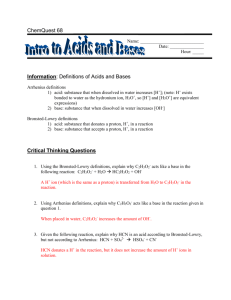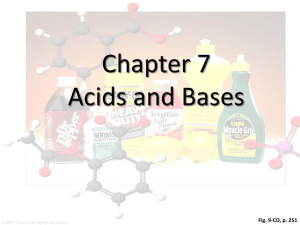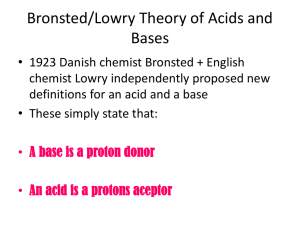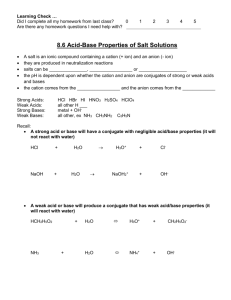lec #2 By: Mahmoud Qaisi
advertisement
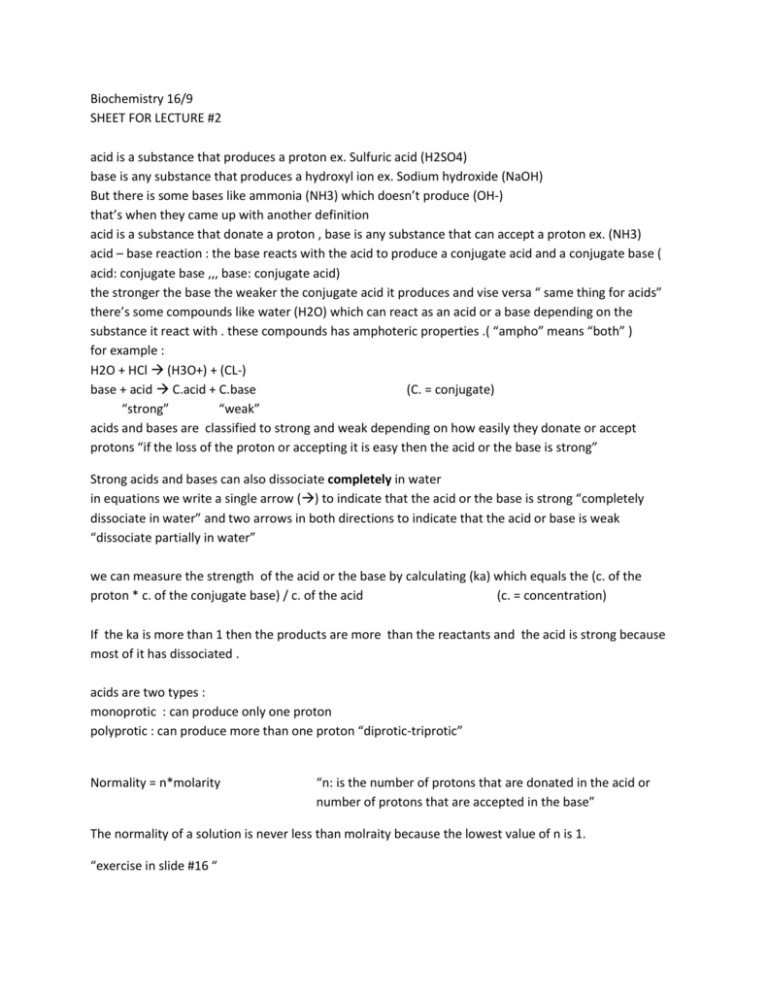
Biochemistry 16/9 SHEET FOR LECTURE #2 acid is a substance that produces a proton ex. Sulfuric acid (H2SO4) base is any substance that produces a hydroxyl ion ex. Sodium hydroxide (NaOH) But there is some bases like ammonia (NH3) which doesn’t produce (OH-) that’s when they came up with another definition acid is a substance that donate a proton , base is any substance that can accept a proton ex. (NH3) acid – base reaction : the base reacts with the acid to produce a conjugate acid and a conjugate base ( acid: conjugate base ,,, base: conjugate acid) the stronger the base the weaker the conjugate acid it produces and vise versa “ same thing for acids” there’s some compounds like water (H2O) which can react as an acid or a base depending on the substance it react with . these compounds has amphoteric properties .( “ampho” means “both” ) for example : H2O + HCl (H3O+) + (CL-) base + acid C.acid + C.base (C. = conjugate) “strong” “weak” acids and bases are classified to strong and weak depending on how easily they donate or accept protons “if the loss of the proton or accepting it is easy then the acid or the base is strong” Strong acids and bases can also dissociate completely in water in equations we write a single arrow () to indicate that the acid or the base is strong “completely dissociate in water” and two arrows in both directions to indicate that the acid or base is weak “dissociate partially in water” we can measure the strength of the acid or the base by calculating (ka) which equals the (c. of the proton * c. of the conjugate base) / c. of the acid (c. = concentration) If the ka is more than 1 then the products are more than the reactants and the acid is strong because most of it has dissociated . acids are two types : monoprotic : can produce only one proton polyprotic : can produce more than one proton “diprotic-triprotic” Normality = n*molarity “n: is the number of protons that are donated in the acid or number of protons that are accepted in the base” The normality of a solution is never less than molraity because the lowest value of n is 1. “exercise in slide #16 “ • What is the normality of H2SO3 solution made by dissolving 6.5 g into 200 mL? (MW = 98)? N= n*molarity N=2*(6.5/98/0.2) = 0.663 Equivalents : For compounds that have (H+) in them the number of equivalents for these compounds is equal to the number of (H+) in one mole of the compound “ ”او ما يعادلها بالغرامات ex. 1 mol of HCl has one equivalent / also 36.5 g “which = 1mol” of HCl has one equivalent ex. 1 mol of H2SO3 has two equivalents therefore one equivalent for this compound is in 0.5 mol / also 98 g “which equals 1 mol of this compound” has two equivalents ( and 49 g “98/2” “0.5mole” has 1 equivalent” For charged ions the number of charges is equal to the number of equivalents in one mole “ او ما يعادلها ”بالغراماتof this charged ion Ex. 1 mole of (Na+) /23 g of (Na+) has one equivalent Ex. 1mole of (Mg+2)/24.3 g of (Mg+2) has two equivalents therefore 0.5mole of (Mg+2)/12.15 g of (Mg+2) has one equivalent “ Example in slide 20” • calculate the number of equivalents of: 1.) 40g of Mg+2 2.) 16g of Al+3 1.) for Mg+2 24 g “molar mass of Mg” has 2 equivalents ( 24 g 2 Eq ) then for 40 g it has ?? equivalents ( 40 ??Eq ) therefore 40*2/24 = 3.33 Eq 2.) for Al+3 27 g “ molar mass for Al” has 3 equivalents. Then for 16 g it has ?? equivalents Therefore 16*3/27 = 1.8 Eq “Table slide 22” physiological grams of (HPO4 -2) : molar mass for (HPO4 -2) = 96 g 1 mole of (HPO4)/ 96 g of (HPO4) has 2 equivalents then ?? mole/ ?? g of (HPO4) has 2 mEq (2mEq = 0.002Eq) Therefore 0.002*96/2 = 0.096 g Titration : trying to know the concentration of an unknown amount of (acid or base) by neutralizing it by a (base or acid). equivalence point is the point where the protons and hydroxyl ions in a solution is equal and ph is 7 . To calculate anything within titration use this equation n(acid) *M(acid) *V(acid) = n(base) *M(base) *V(base) (n number of “H+” in acid and “OH-“ in base) Ionising water H2O + H2O (H3O+) + (OH-) This reaction is in equilibrium therefore it has an equilibrium constant (keq) Keq = [H3O+] * [OH-] / [H2O] = 1.8*10^-16 molar “CONSTANT” Another constant is the concentration of water “pure” = 55.5 molar From the previous equation keq*[H2O] = [ H3O+] * [ OH-] ( keq * [H2O] = 1.8*10^-16 * 55.5 = 1*10^-14=kw) Kw = [H3O+] * [OH-] = 1*10^-14 This means that if we increase the concentration of (H3O+) then the concentration of (OH-) must decrease because kw is constant “and vise versa” *PH can theoretically be below zero “for example if we have 10 molar of HCl then the PH is -1” * when ka increases acidity increases *when pka decreases acidity increases

